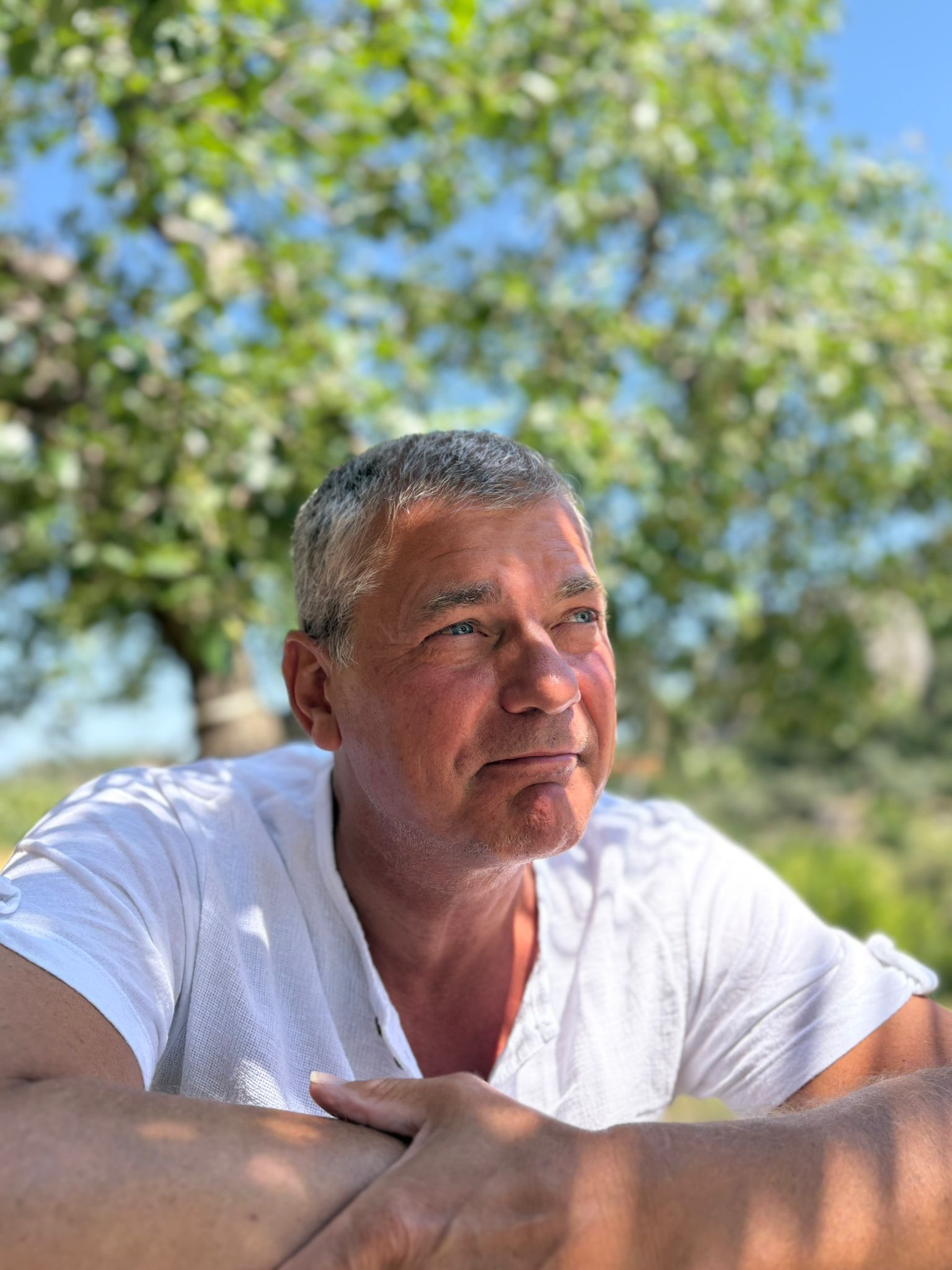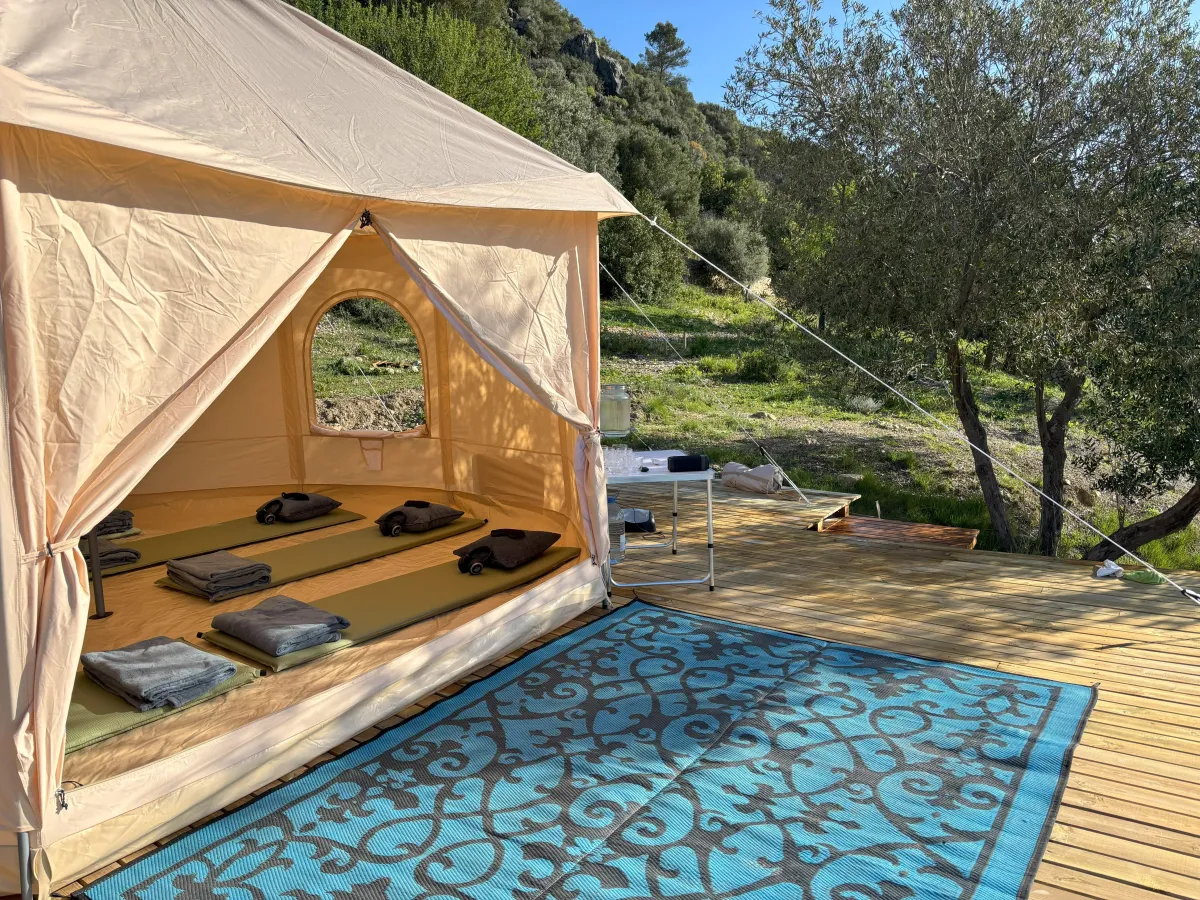SoulBreathMallorca
Reconnect with yourself
9D Breathwork & More by Danny Veerman
Group Sessions
Private Sessions
Men's Retreat
Let your breath do the talking
"It feels like my mind is always on and I can't relax"
"I need to make a change but I don't know how"
"I'm just not good enough"
Relateble?
Stress, lack of self-love, anxiety, a struggle to let go.
There are so many people who feel this way.
The good news: you can fix it!
It all starts with reconnecting: with your body and mind.
Transformation through breathing
Why breathwork?
relaxation
stress release
total reset
Body-mind connection
transformation
mental clarity
What people say

"A true game-changer"
"The 9D Breathwork experience was a true game-changer for me. It is great for anyone looking to dive deep into self-exploration, healing, and transformation. Unlike traditional breathwork practices, 9D Breathwork incorporates binaural beats, subliminal messaging, guided visualization, and deep rhythmic breathing to create a multi-sensory journey that activates different layers of consciousness. Danny is a true professional that steps in at the moments I needed it the most. He touched one' s hand, belly or chin just to make you aware you keep breathing. I can definitely recommend to experience this amazing session with Danny!!"
Leonie Wagemakers


"Unique and intense experience "
"Thank you so much for this unique and intense experience. The location is absolutely stunning. As the weather was not as perfect we got to do the breathwork inside in the living room. Everything was well prepared with super comfy mattresses pillows and blankets headphones and eye mask. Danny’s voice is so calming and the session was just perfect. You have the feeling he is fully connected and there whenever you need any help or guidance. I had no expectations as this was my first sessions and I was so overwhelmed and relieved at the same time that I had to cry … it was beautiful".
Marcia Schwarz


"I would totally recommend him"
"TI recently participated in a 9D Breathwork session with Danny and had a great experience. The space was very cosy and well prepared with comfortable mats and pillow, everything you need. He introduced us well, answered all questions and I felt very safe and gently guided during the whole session. He is an amazing Facilitator & I would totally recommend him to anyone who is looking for a deep emotional release and ready for a change in their life
Annika Teuber

What is 9D Breathwork?
9D Breathwork combines conscious connected breathing with sound, frequency and guided voice. It’s a full-body, full-system experience, designed to help you release emotional blocks, rewire your nervous system, and come back to clarity and calm.
During a session, you breathe in a continuous flow. This first activates your symphetatic nervous system (fight or flight). Some people will experience a tingling sensation in hands and sometimes also in their feet. Numbness in the facial area is also common side-effect.
It is important to build up slowly: think of it as a marathon, not a sprint
Then your parasympathetic nervous system kicks in (rest and digest) and you will start to feel calmer. Simaultaneousy your brain (your lymbic system) will be allowing suppressed emotions, memories or energy to surface.
Some people feel the need to cry, some feel euphoric. It's all part of the experience
At the end as you slown down your breath, your system shifts, from tension to deep relaxation. You return to a calm, grounded state where real integration happens.
Each 9D journey is uniquely programmed to meet a specific theme — whether that’s letting go, rebuilding inner strength, or unlocking stored energy.
You don’t have to figure it out. Just breathe, and your body will do the rest.
Hey, I'm Danny
March 17, 2023 my daughter Sarah died in an avalanche in Serfaus, Austria. The day after, after seeing her in the hospital, I panicked and almost lost myself, Then a little voice in my head told me to breathe. I remembered how form a breathing session years before.
That moment gave me strenght. It calmed me and gave me the strenght to keep on keeping on.
Breathwork became my lifeline. Day by day it helped me process my pain, release what I couldnt put in words. Through my breath I found a way forward, away from alcohol and medication. I realized breath is a precious medicine and I started learning everything about it.
When I discovered 9D Breathwork something clicked. The combination of music, guidance, binaural beats, solfeggio frequencies, sublimanal messaging. It brought everything together. I knew I had to share this.
I decided to step away from my career as a mediator and lawyer and dedicate myself to helping others find calm, clarity, and strength. One breath at a time.
Check my ratings on google

9D Breathwork
9D group session
A session with a maximum of 8 participants.

If you are not satitsfied I will return your payment in full

an introduction in different breathing techniques
a guided 9D breathwork journey
filled with binaural beats and solfeggio frequenties
subliminal messaging and NLP
total relaxation
€ 60 (session of 3 hours)

"Incredible discovery!"
"an incredible discovery what breathing can do with your body and mind. - Dmytro Grygorenko
Book your session
Frequently Asked Questions
What can I expect during a session?
I will welcome you and give an introduction into in breathwork. During this introduction we go through the contra-indications and possible side-effects. And we will practice different breathingtechniques.
After this we start the sessions. A matt, pillow, blanket, blindfold and headphones are waiting for you.
Once you are installed, familiarized with the headphone, the session will start. It takes between 60-80 minutes, approximately 45 of which are active connected breathing.
At one ore more points there will be a breath-hold and the possibility to let go of what you need to let go with a big sigh or scream.
After the active breathing you slow your breathing but the session continues with relaxation and integration.
Is 9D Breathwork safe?
Is Breathwork Safe?
In most cases, breathwork is a safe and beneficial practice that can be done by nearly anyone. It has been scientifically shown to support both physical and mental well-being and is even recommended by medical professionals to improve breathing capacity and reduce stress.
That said, if you’re new to breathwork or have specific health concerns, it’s a good idea to start with a trained facilitator, through private sessions, group workshops, or retreats.
That way, you can safely explore the practice in a supportive and guided environment.
10 Important Safety Considerations Before Starting Breathwork
While breathwork is generally safe, there are certain medical conditions that require extra caution. If any of the situations below apply to you, it’s best to consult your doctor before starting a breathwork practice.
1. Respiratory Conditions
Breathwork can improve lung function and support conditions like asthma or COPD. However, if you have chronic breathing issues or respiratory disease, some techniques may be too intense. Always check with your doctor to find the exercises that are right for you.
2. Cardiovascular Issues
If you have a heart condition—such as high blood pressure, arrhythmia, angina, or a history of heart attack—proceed with care. Breathwork can influence heart rate and blood pressure. Your doctor can advise whether it’s safe and suggest suitable techniques.
3. Pregnancy or Breastfeeding
Pregnant or breastfeeding individuals may be more sensitive to the effects of breathwork. Gentle, beginner-friendly breathing exercises may still be helpful, but it's essential to consult with your healthcare provider first.
4. Medication Use
Some medications, especially antipsychotics, may affect how your body processes oxygen and blood flow. If you’re on any prescription medication, speak to your doctor about how it might interact with breathwork practices.
5. Recent Injury or Surgery
If you’re healing from an injury or surgery, intense breathing exercises could interfere with your recovery. Your healthcare provider can guide you on whether it’s safe to begin breathwork, and which techniques to avoid.
6. Osteoporosis
Certain breathwork practices involve physical engagement that might strain those with osteoporosis. If this applies to you, stick to gentle exercises and check in with your doctor before beginning.
7. Vision Conditions
Conditions like glaucoma or retinal detachment may be affected by changes in oxygen pressure during breathwork. Those with serious eye conditions should consult a medical professional before starting a breath practice.
8. Severe Mental Health Disorders
Breathwork can help with anxiety, depression, and PTSD, but it’s not a substitute for professional mental health care. People with severe mental illness should approach breathwork in collaboration with their doctor or therapist.
9. Seizure Disorders
If you have a history of seizures, certain breath techniques may pose a risk due to changes in oxygen flow. Always consult with a medical professional before beginning any breath-based practice.
10. Personal or Family History of Aneurysms
Because breathwork affects circulation and oxygen levels, it could present a risk for those with aneurysms or a family history of them. Speak with your doctor to evaluate if breathwork is safe for you.
When in Doubt, Ask
Breathwork can be incredibly powerful, but it’s not one-size-fits-all. If you’re unsure, always speak with a healthcare professional first. And remember: working with a trained facilitator can help you find techniques that feel both safe and effective for your body and mind.
Are there any side-effects?
1. Dizziness
Feeling lightheaded or dizzy is one of the most common side effects of breathwork. It’s often caused by reduced oxygen levels due to over-breathing or improper technique. If you feel dizzy, pause, return to slow, natural breathing, and consider practicing under the guidance of a trained facilitator.
2. Tingling in Hands, Feet, or Face
Tingling sensations, especially in the arms, legs, hands, or face, can be a sign of hyperventilation. This happens when oxygen and carbon dioxide levels in the body become unbalanced. It’s generally harmless but a signal to slow down and ground yourself.
3. Chest Discomfort
Breathwork can affect how your respiratory and circulatory systems function, sometimes leading to chest tightness or discomfort. If you experience chest pain during a session, stop immediately, rest, and consult a medical professional if the sensation doesn’t subside.
4. Irregular or Rapid Heartbeat
Some people notice a racing or irregular heartbeat during or after breathwork. If you have a heart condition or are prone to palpitations, it’s especially important to choose gentle practices and check with a healthcare provider before starting breathwork.
5. Muscle Spasms
Muscle cramps or spasms, especially in the diaphragm, hands, or around the mouth, can occur during intense breathwork due to shifts in oxygen and carbon dioxide levels. Slowing your breath and relaxing your body can usually resolve this quickly.
6. Blurred or Cloudy Vision
Changes in vision during breathwork may feel alarming but are typically temporary. They’re often linked to oxygen flow or pressure changes. If this happens, stop the practice and return to a calm, steady breath.
7. Ringing in the Ears
Some people experience ringing or buzzing in the ears, especially those who are sensitive to sound or have tinnitus. If this occurs, return to gentle breathing and take it as a cue to reduce the intensity of the practice.
8. Emotional Release or Distress
Breathwork can unlock deep emotions, memories, or trauma. While many people find this healing, others may feel overwhelmed. Always go at your own pace and consider working with a facilitator who can support you through emotional processing.
9. Risk of Psychotic Experiences
For some individuals, especially those with a history of psychosis or dissociation, certain breathwork practices may trigger destabilizing experiences. It’s important to speak with a mental health professional before engaging in breathwork if you have concerns about your psychological safety.
10. Seizure Risk
People with a history of seizures should approach breathwork with caution. Changes in oxygen levels can sometimes act as a trigger. Always consult your doctor before beginning any breath-based practice if you’re managing a seizure disorder.
Practice with Awareness
Breathwork can be deeply transformative, but it’s important to approach it with care. Listen to your body, know your limits, and don’t hesitate to ask for infomation, explantion or guidance.

Is it suited for everyone?
As described under 2 there can be contra-indications. But if you do not have any of the physical or mental contra-indications you may do it.
Do realise that Breathwork can be incredibly powerful. It is not a one-size-fits-all. If you’re unsure, always speak with a healthcare professional first.
When doing a conscious connected breathwork session it is likely that you may experience some side-effects. This is quite normal. If you are not willing to do so, it is not for you.
Also people who are very sensitive to sound may find the 9D sessions too much and overpowering.
In that case consult with me to see if other breathing techniques are more suited for you, like box breathing or 4-7-8 breathing.
What can I expect after a session?
A 9D Breathwork session is a powerful and immersive experience. It combines conscious breathing with music, sound healing, and guided journeys designed to activate all your senses and support emotional, physical, and energetic release. Every session is unique, but here’s what you might experience afterward:
Deep Sense of Calm
Many people leave a session feeling deeply relaxed, as if a weight has been lifted. Your nervous system may shift into a parasympathetic (rest-and-digest) state, bringing a sense of inner peace, stillness, and grounding.
Emotional Release
It’s common to experience a release of stored emotions, even those you didn’t know were there. You might feel lighter, more open, or more connected to yourself. Tears, laughter, or a sense of spaciousness are all welcome and valid responses.
Mental Clarity
After a session, your mind may feel clearer and more focused. Many people report insights, creative ideas, or a renewed sense of direction. It's a great time to journal, walk in nature, or reflect.
Renewed Energy
Once the integration begins, you might feel an energetic boost, increased motivation, or a sense of vitality. Breathwork can clear energetic blockages and help you feel more alive in your body.
Temporary After-Effects
Because 9D Breathwork is such a deep practice, you might also experience some temporary side effects, like:
Fatigue or needing extra rest;
Heightened sensitivity or emotions;
Vivid dreams or memories resurfacing;
This is all part of the body’s natural integration process and usually passes within 24–48 hours. Drinking water, taking it easy, and allowing yourself space to feel can support this.
A Stronger Connection to Yourself
Above all, people often report feeling more connected, to their intuition, their body, their emotions, or something greater than themselves. This connection is where true healing and transformation begin.
Integration Is Key
After a 9D Breathwork session, give yourself time to rest, reflect, and integrate. Breathwork is not just a moment, it’s an opening. Stay curious about what it brought up for you, and treat yourself with compassion in the hours and days that follow.A 9D Breathwork session opens you up. You may have found a solution for a problem, or have experienced a strong release of stress, anxiety and negative emotions. You might feel lighter, clearer, more relaxed, more open, reset.

It’s a natural detox.
Small Call to Conscious breathing helps flush out toxins and stagnant energy. You feel lighter, clearer.

It boosts mental clarity.
After a session, your mind feels reset, like someone wiped the fog off the glass.

It’s always with you.
No apps, no tools, just your breath. Ready whenever and wherever you are.

Emotional release
You don’t have to talk it out. Stuck emotions surface and move through you, just by breathing.
SoulBreathMallorca
Danny Veerman is a breathwork facilitator and coach who lives and works on Mallorca.
He is located in Mancor de la Vall, close to Inca. You are always welcome to give him a call in order to discuss if breathwork if suited for you.
e-mail: [email protected]
mobile: +34 686 701 080